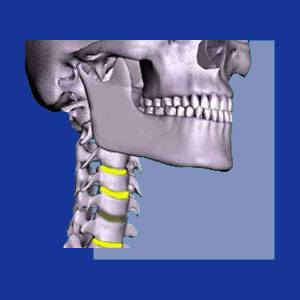
Did your doctor diagnose a degenerated cervical disc? Before doing anything, you absolutely must learn the facts about spinal disc degeneration and understand why the condition is 100% normal. This is a truth that escapes most diagnosed patients, who immediately begin to panic when told of their “crumbling spine”.
Cervical disc degeneration describes the condition more commonly known as degenerative disc disease, although technically, this name is a complete fabrication of a financially-motivated medical juggernaut. The actual and proper diagnostic name of the condition is intervertebral desiccation, but this is a term you almost never hear uttered during diagnostic consultations. Do you know why?
This essay paints a vivid and accurate picture of the structural changes inherent to cervical degenerative disc disease. We will examine some crucial facts that patients must know before seeking any type of treatment for any variety of cervical disc degeneration diagnosis.
What is a Degenerated Cervical Disc?
Degeneration is basically a name for the changes that occur in all organic structures due to age and physical activity. After all, just like for inanimate objects, the use of any body part will also cause wear upon the tissue. The spinal discs are designed to insulate the individual vertebral bones from one another, as well as absorb and distribute shock in the spinal column. These discs also provide additional length for the spinal column, encompassing about 25% of its overall length. Most importantly, the spinal discs facilitate the extensive range of motion that the human spine is capable of producing. If not for these discs, the spine would simply be a fused mass of solid bone and humans would be very different organisms, for sure.
Degeneration takes specific forms in the intervertebral discs. The process is universally expressed by all adults, although the extent of the degeneration presented can vary greatly due to genetic and developed factors. Disc degeneration is most often observed in the middle to lower cervical spinal levels in adults past the age of 30. Degeneration causes the discs to dry out, facilitating cracks in the annulus fibrosus, which is the outer disc wall. Meanwhile, the nucleus pulposus, or soft inside of the disc, tends to dehydrate also, causing the mass of the disc to shrink considerably. This is why desiccation is the proper diagnostic term.
Degenerated Cervical Disc Scapegoat
Disc degeneration in the neck is universally expressed in adults. It is expected, normal and completely nonpathological. However, in very rare cases, cervical disc degeneration can produce some painful effects, so it is of interest to objective physicians and complementary healthcare providers. However, this level of interest is not commensurate with its pathological potential. In fact, degenerative disc disease is the greatest scapegoat of all in the back and neck pain industry.
Do you know who has degenerative disc disease? Everyone, including your doctor. Do you know who requires treatment for this condition? Virtually no one. This is objective medical fact. The vast majority of diagnosed cases are complete nonissues, yet so many are blamed as being a source of pain, even when no pathology exists. This is called scapegoating and the cervical discs are scapegoated more than any other spinal tissue except for the lower lumbar spinal discs of L4/L5 and L5/S1.
Degenerated Cervical Disc Factsheet
So, for the benefit of basically every adult reader who comes across this page and feels that their life is over due to experiencing disc degeneration in the neck, we have these most important words of wisdom:
Not all disc degeneration is 100% innocent. Disc degeneration does incite the osteoarthritic processes and these can contribute to such serious conditions as central spinal stenosis and neuroforaminal stenosis. However, mild to moderate stenosis are normal occurrences and most spinal arthritis will never become overly, if at all, symptomatic. Similarly, disc deterioration facilitates herniated discs, but as we teach, most intervertebral bulges are also normal and completely nonissues. Some herniated discs can compress nerve tissues, but this occurrence is actually very rare.
Now that we have that disclaimer out of the way, here are the facts you really need to absorb and commit to memory… First, if you above the age of 40, we can 100% accurately diagnose degenerative disc disease in you without ever examining you. The condition is literally universal. Virtually all disc deterioration in the neck is harmless and although it will change spinal structure, it will not necessarily create spinal pathology.
If degeneration was inherently painful, then any student of medicine or human anatomy would logically conclude that since the process continues for life, symptoms would worsen as a person ages. However, this is contrary to statistical fact that shows disc pain to be far, far less common in the elderly than in people aged 25 to 55. Therefore, degeneration is not the source of pain, nor is the process truly degenerative, since is does stabilize in almost all patients once the disc has thoroughly desiccated.
Finally, treating a completely normal and expected variety of spinal change seems ridiculous. Medical history shows little mention of chronic pain of any type for millennia and even less mention of chronic neck pain. If degeneration was the cause, then our ancestors would have suffered at least as badly as we do, if not worse, but this is simply not the case.
In summary, the way modern medicine views degenerated cervical discs is little more than a economic incentive for making money by treating yet another structural change that can surely be observed and documented, but truly has little relevance to health or expressed pain. Once you understand this fact, you will finally be on the right path towards discovering what is really causing your pain…
Neck Pain > Degenerative Disc Disease Neck Pain > Degenerated Cervical Disc





